
Hasegawa 1/48 Ju-87G-2 Stuka
|
KIT # |
9054 (JT 54) |
|
PRICE: |
$29.98 MSRP |
|
DECALS: |
Two aircraft |
|
REVIEWER: |
|
|
NOTES: |

|
HISTORY |
Ask almost anyone who knows little about airplanes to name a German airplane of the Second World War, and the odds are, the name they'll come up with is "The Stuka." When my brother first got involved in falconry, his first Peregine falcon was named - quite appropriately - "Stuka."
The Junkers Ju-87 "Stuka"
- the name comes from Sturzkampfflugzeug, or "diving battle airplane",
a generic term for all dive bombers but which became intimately associated
with this design above all others - was the victim of propaganda on
 both sides. The Germans
hailed it as a wonder machine as it swept the skies over Poland and France;
the British derided it as little more than a flying target a few months
later. The truth, as is usually the case, was somewhere in the middle.
both sides. The Germans
hailed it as a wonder machine as it swept the skies over Poland and France;
the British derided it as little more than a flying target a few months
later. The truth, as is usually the case, was somewhere in the middle.
The Stuka was, with the Douglas SBD "Dauntless", one of the two most successful designed-for-the-purposed dive bombers of the war. Neither had a great performance, but both could be dived at near-vertical angles and lay their bomb on the target with great effect. Both depended for their survival on a modicum of air superiority by the fighters on their side, at least for the duration of the attack. Both were surprisingly maneuverable, and if attacked by a solo enemy stood a very good chance of not only getting away clean, but also turning the tables on the overconfident fighter pilot and shooting him down. Both were deadly to ships and were the greatest ship-killers of their respective air forces.
By 1942, it had been determined that the Ju-87B would be phased out of production, but its intended replacement had failed - as was the case with nearly every replacement of a first-generation German combat airplane of the war. The result was that Junkers undertook a program to clean up the ungainly-looking airframe aerodynamically, resulting in the Ju-87D series, which appeared that summer.
By that summer, the
Germans had been fighting on the eastern front for a year, and had discovered
that dive-bombing 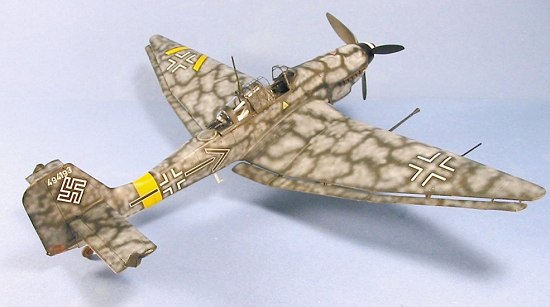 tanks was
not the way to knock out enemy armor. On June 26, 1941, the entire strength of
Stuka Geschwader 2 attacked some 60 enemy tanks 50 miles South of
Grodno, knocking out only one tank.
tanks was
not the way to knock out enemy armor. On June 26, 1941, the entire strength of
Stuka Geschwader 2 attacked some 60 enemy tanks 50 miles South of
Grodno, knocking out only one tank.
The answer was the Ju-87G, a Ju-87D-5 airframe converted to carry a pair of 37mm Flak 18 cannon, outboard of the main gear. The installation had been tested operationally in the summer of 1942 with a modified Ju-87D-3. The Panzer Staffel of St.G.2, under the leadership of Oberleutnant Hans-Ulrich Rudel, was so successful that a PanzerJaeger Staffel was added to each of the Schlactgeschwader units created from the old Stuka Geschwadern in October 1943. By this time, Junkers was producing the Ju-87G-2 directly at the factory.
By the fall of 1944, only Rudel - by then Geschwader Kommodore of SG2 - kept a PanzerJaeger Staffel of Ju-87Gs in the unit. The airplanes were slow and unwieldy on the battlefield, but he still trusted the Stuka. By the end of the war, he would score 519 Soviet tank kills. His book, "Stuka Pilot," reveals a young man of great naivete who went off to join the Luftwaffe in 1938, and unreflectively believed what his leader told him. In this he was not unlike many on both sides of the coming conflict. Rudel was different in that he became one of the few Luftwaffe officers to become a member of the Nazi Party, and one who enforced Nazi discipline in his unit until to the end. As the only member of the German armed forces to be awarded the Gold Knights Cross with Diamonds and Swords, he believed the propaganda that was manufactured about him. In his book, he calls what the Germans were doing in Russia "our struggle for freedom." After the war, Rudel remained a believing Nazi and was briefly imprisoned in the early 1950s for being part of an attempt to refound the Nazi Party in West Germany. From the 1960s to his death in 1987, he was a leader of the New Democratic Party, the neo-Nazis of West Germany.
Like several Allied aces, Rudel is the kind of man whose deeds on the battlefield can be respected, but whose personal beliefs and actions were repellent.
|
THE KIT |
The Hasegawa Ju-87G-2 first came out in about 1998, if I recall correctly. It was the second Ju-87 tank killer to be released in 1/48, the first being the now-venerable Monogram kit, which was first released in 1968.
To me, both of the Hasegawa Stuka kits - the Ju-87B series and the Ju-87D/G series - suffer from the lack of surface detail. The Stuka was most definitely not a flush-riveted airplane, not anywhere on its airframe. In this respect, the Airfix Ju-87B is the Stuka kit that comes the closest to recreating the complete aerodynamic klunkiness of the Stuka.
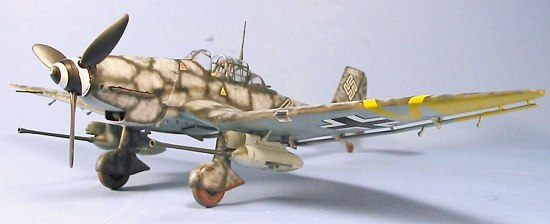 This specific kit is
developed from the Ju-87D-3 kit, and has extended wingtips that suffer from
the fact that the mold was not correctly positioned when it was changed,
resulting in a distinct "ridge" where the outer wingtip is molded that must be
sanded down before further assembly. This kit also includes two sprues of
parts for the Flak-18 cannon, including barrel, cannister, ammo clip and
ejection, and the mounting pylon and sway braces. These are vastly more
detailed than the similar parts in the old Monogram kit.
This specific kit is
developed from the Ju-87D-3 kit, and has extended wingtips that suffer from
the fact that the mold was not correctly positioned when it was changed,
resulting in a distinct "ridge" where the outer wingtip is molded that must be
sanded down before further assembly. This kit also includes two sprues of
parts for the Flak-18 cannon, including barrel, cannister, ammo clip and
ejection, and the mounting pylon and sway braces. These are vastly more
detailed than the similar parts in the old Monogram kit.
The canopy comes in four sections and can be posed open.
The Ju-87G-2 kit includes only decals for Rudel's final Stuka. The decals are thick, with the white an "ivory" color, and are best replaced with aftermarket decals. Given there are no other decals that provide the pre-war Geschwader Kommodore markings in the size needed, you will need to use those from the kit sheet if you intend to do Rudel's airplane. (Editor's note: Superscale 48-719 provides markings for Rudel's last Stuka. The link includes photos, though not the winter scheme.)
|
CONSTRUCTION |
Construction began with the cockpit, with all parts airbrushed in RLM66. While that was drying, I assembled the wing and set it aside to set up.
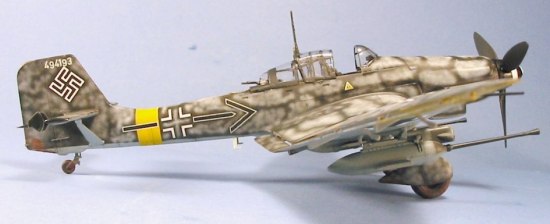 After doing the
detail painting of the cockpit and assembling it, I attached seat belts made
from lead foil, and assembled the fuselage.
After doing the
detail painting of the cockpit and assembling it, I attached seat belts made
from lead foil, and assembled the fuselage.
At that point, I decided I should have assembled the engine cowling parts to their respective fuselage halves before assembling the fuselage halves, since the cowlings would have fitted better. After a lot of fiddling, I got this to work and set the fuselage aside to set up. I then assembled the wheels and their respective spats, and assembled the cannons.
Next session, I attached the wing subassembly to the fuselage sub-assembly, then attached the horizontal stabilizers, and finished with the landing gear. I applied Mr. Surfacer as necessary to the various seams and joints and set it aside.
With the seams and joints sanded down, the model was ready for the paint shop.
|
CAMOUFLAGE & MARKINGS |
Since I had run across a photo on the internet of this airplane in its winter camouflage from 1944-45, I decided I would do that scheme. This meant painting the 70-71/65 camouflage, then applying the decals, then painting the white blotches over the upper surfaces around the markings, as was shown in the photograph and the profile the webmaster had created.
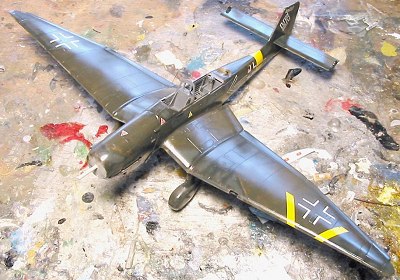 After painting the RLM04
Yellow theater markings and masking them off, I started with Gunze-Sangyo
RLM65, masked that off, then shot Gunze-Sangyo RLM71, fading it with
re-applications of the color with a brushful of white added each time. I then
painted the RLM70 pattern freehand. Since this was going under a winter camo,
I didn't feel I needed to mask and shoot for a sharp edge of color
demarcation.
After painting the RLM04
Yellow theater markings and masking them off, I started with Gunze-Sangyo
RLM65, masked that off, then shot Gunze-Sangyo RLM71, fading it with
re-applications of the color with a brushful of white added each time. I then
painted the RLM70 pattern freehand. Since this was going under a winter camo,
I didn't feel I needed to mask and shoot for a sharp edge of color
demarcation.
When it came time to do the decals, I used a variety of decals from the dungeon for the national markings, and the kit decals for the serial number and the personal markings. When that was all set up, I gave the model a coat of Future.
The winter camo was done using Tamiya Flat White, thinned 50-50 with rubbing alcohol, and applied in small bits, starting in the middle of the "blotch" and extending it out to fit around the markings per the photograph.
When all this was done, I Futured the model again.
|
FINAL CONSTRUCTION |
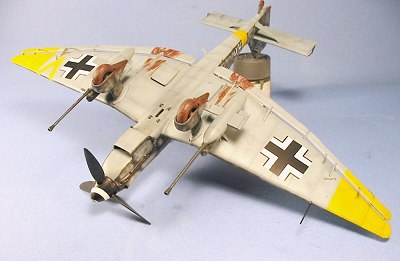 I attached the
horizontal stabilizer braces, the landing gear, the cannons and the prop
(which had been painted black and had its spiral done with a decal from the
Luftwaffe wing of the decal dungeon).
I attached the
horizontal stabilizer braces, the landing gear, the cannons and the prop
(which had been painted black and had its spiral done with a decal from the
Luftwaffe wing of the decal dungeon).
I then applied several coats of thinned Dullcote, then attached the canopies.
I finished off by applying some exhaust staining with Tamiya "Smoke", and muddied up the wheels and landing gear and lower wing, as would befit an airplane operating in the primitive conditions of the eastern front.
|
CONCLUSIONS |
There you have it, an airplane flown by a for-real Nazi. The angular ugliness of the Stuka is such it looks exactly like what it was: a bird of prey for a regime of death.
April 2003
Tom Cleaver
Copyright ModelingMadness.com. All rights reserved. No reproduction in part
or in whole without express permission. Kit courtesy of my
wallet!
If you would like your product reviewed fairly and fairly quickly, please contact the editor or see other details in the Note to Contributors.